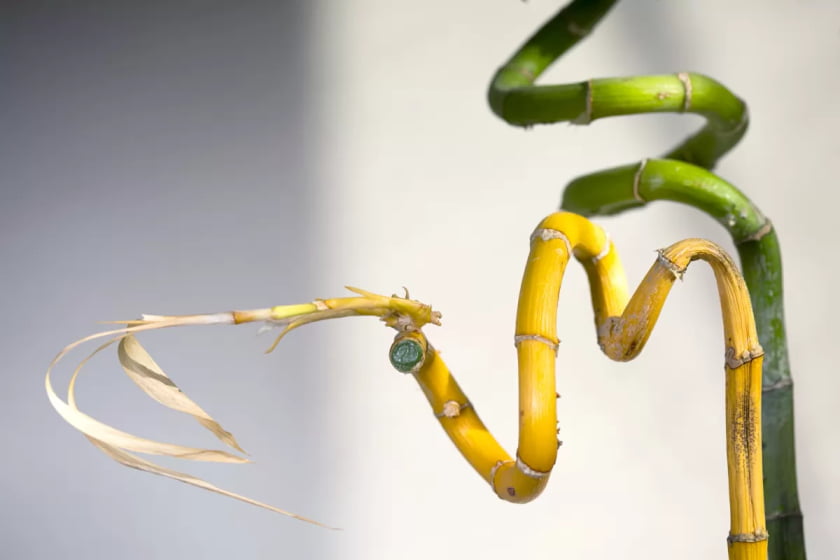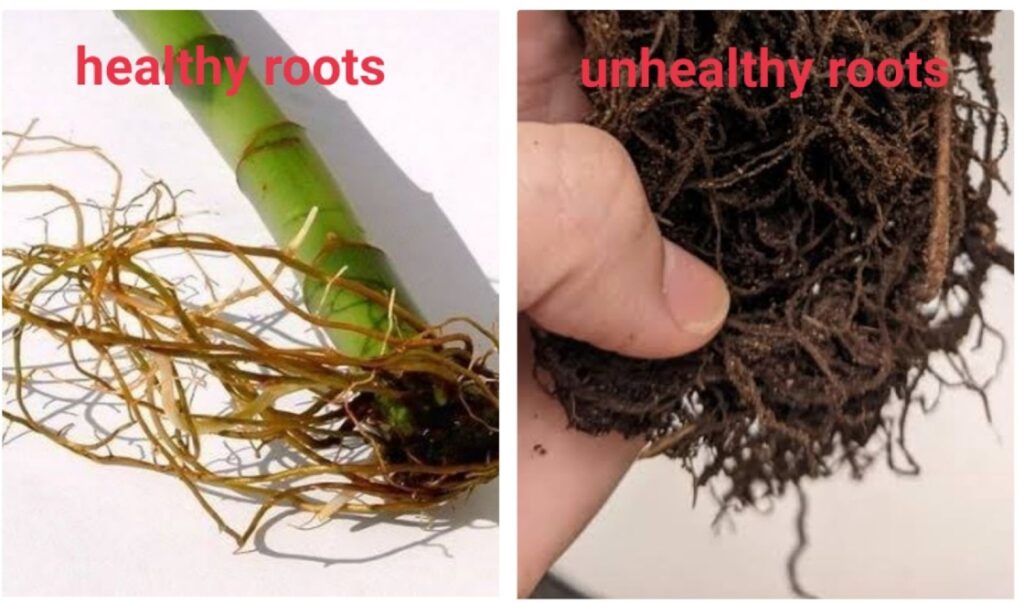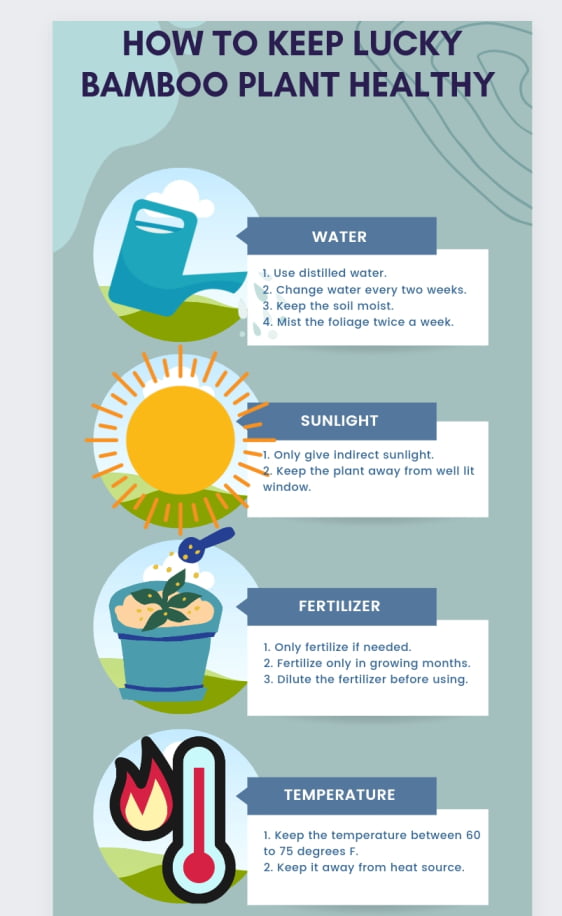
Lucky bamboo (Dracaena sanderiana) is mainly cultivated for the symbolism it holds, which is good fortune, wealth, and positivity. Along with its slender, elegant, and lustrous beauty, it’s easy to care for as well. But even if they are easy to care for, one unfortunate sight can be prominent and that is your bamboo plant turning yellow.
The reasons can be concerning but not uncommon, it goes without saying, that the cure is possible. Last year I noticed my indoor lucky bamboo turned yellow. It confused me cause they are known to be easygoing, so where did I go wrong? After countless hours of researching and observing my plants up close, I realized that my water temperature was not perfect for them (who would have thought?).
Anyways, while researching I found out there’s not only one but multiple reasons that can turn a bamboo plant’s vibrant green colour into dull yellow and I made this post to share those causes with you so that you can understand the reason immediately and move accordingly to restore your plant’s lost charm.
Why is my Lucky bamboo plant turning yellow?
As mentioned earlier there is more than one reason why lucky bamboo stalks and leaves start to turn yellow. The cause can depend on where your plant is staying, indoors or outdoors, but most general causes are the same for both places. These are;
- Improper watering.
- Excessive sun exposure.
- Too much fertilizer.
- Humidity and temperature.
- Pests.
- Aging.
Let’s go through them one by one and discuss how to save bamboo plant when it turns yellow.
What are the causes of lucky bamboo turning yellow?
Water-related issues
Water-related issues are the primary reason for yellowing bamboo stalk. These trees can be grown in both water and soil, so water-cultivated plants require accurate water quality, temperature, and replacement, while soil-cultivated plants only require their soil to stay moist.
Is my water turning my lucky bamboo plant yellow?
The source of the water plays a vital role in the health of the tree. Tap water is most easily accessible but at the same time using it on your tree will cause the tree to fail even before you start (especially if you are growing it in water). Tap water has chlorine, fluoride, and other chemicals that are not suitable for your tree. If your tree is constantly living with those chemicals it will not only turn yellow but die as well. The yellow bamboo stalk is just an early symptom.
Is water temperature the reason behind the bamboo stalk turning yellow?
I know it might sound hard to believe but when you are changing water for your plant if the water is too cold it will make the leaves of the plant yellow.
Is lucky bamboo in water turning yellow due to not refreshing?
Just like soil-grown trees need re-potting, water-grown trees need water replacement as well, but the only difference is the water needs to be replaced more frequently.
If the tree is sitting in water for longer it will set up various fungi, molds, and bacteria, and along with that nitrogen and oxygen supply will be less. All these together can be responsible for yellowing bamboo stalks and leaves.
Is the issue related to soil moisture being the reason behind yellowing bamboo stalks?
Other water-related issues are mainly focused on the plant that is cultivated in water, but this one is for the soil-grown plants. For other plants overwatering and underwatering both causes yellowing leaves but for lucky bamboo it’s just underwatering.
Always be vigilant about the moistness of the soil. If these water-loving plants lack water in the soil the leaves and stalks may dry and gradual signs of bamboo stems turning yellow may occur.
Lucky bamboo turning yellow due to direct sunlight:
Every plant requires sunlight, but too much sunlight can affect your lucky bamboo plant’s health and make leaves turn yellow. Lucky bamboo love indirect sunlight, so if your plant is getting direct light for hours, day after day, it is bound to turn yellow.
Sunburn yellowing bamboo stalks and leaves detection is easy, along with yellow leaves you will find dark burn-like spots all over the leaves.
Note:
Too little indirect sunlight can also be responsible for yellow leaves, but instead of burn marks, the tree will be drooping.
Can over-fertilizing cause bamboo turning yellow?
Your bamboo tree will not perform well if they don’t get enough nutrients, but also at the same time, it can get overfed too. Over-fertilized soil makes the plant hard to absorb nutrients. Sometimes they mess up soil pH levels too.
Overfertilized bamboo trees first affect the stalks of the tree and as a result, they turn yellow. Gradually they affect the leaves.
In overfertilization leaves commonly dry out and fall.
How do humidity and temperature affect lucky bamboo turning yellow?
Humidity stress is a common culprit for yellow unhealthy lucky bamboo. Leaves get affected by it most as they are one predominantly absorb moisture from the air. Indoor air is usually drier than outdoor, so the issue arises often when they are staying indoors.
Lucky bamboo can tolerate various ranges of temperatures but they are more inclined towards warm temperatures. So, if the weather is too cold and constant it can turn the leaves yellow.
To determine the cause, understand your atmosphere and experiment with the plant by spraying them and moving them to warmer places for any recovery.
Can pests be responsible for yellow leaves?
If the leaves of the lucky bamboo turning yellow and making patchy formations, the culprit can be pests. Insects like mites and scales suck the nutrients from the plant by inserting their mouthpieces in it. As a result, they leave yellow patchy spots on that place.
They can be detected through the spots, other than that you can use magnifying glasses to detect them.
Is it normal for older lucky bamboo leaves to turn yellow?
If your plant has new growth but the older leaves are only one yellowing, there’s a high possibility that they are just aging. The plant will gradually shed old growth to give full attention to the new development.
Notice the lower part of the plant for discoloration, on mature plants few occasional yellow leaves are normal.
How to save a bamboo plant that is turning yellow?
How can I adjust my watering routine to save my bamboo from yellowing?
What is the ideal water type for lucky bamboo?
Try to give your tree spring water or distilled water.
If you have a rainwater collection system, you can use it as well but make sure the water is not touching or coming down from the asphalt roof as this can infuse some chemicals in the water.
You can give fish tank water as well, they are not as good as rainwater but a small amount of fish waste in fact works as a fertilizer. Telling you from personal experience, it doesn’t smell bad.
R/O Water is also fine for lucky bamboo, but it lacks nutrients so you have to add it additionally.
What is the accurate water temperature?
Instead of giving cold or warm water, wait till it matches the room temperature.
Generally, the ideal temperature for lucky bamboo roots to drink water and nutrients is approximately 68°F. At that temperature, the water holds plenty of oxygen, and it is also precisely the most suitable temperature to activate the pump mechanism in the roots.
How often should I change the water?
Giving fresh water every two weeks is best for lucky bamboo.
If the water smells foul or gets dark and cloudy, change it immediately.
Clean the rocks and the bowl to avoid getting green algae.
Make sure the water level is enough to cover the roots.
How often should I give water to Keep the soil moist?
Soil-grown bamboo tree needs their soil to stay constantly moist. To check the moistness of the soil, insert your forefinger in the soil (for about an inch) and observe the dryness. If it feels dry give it a moisture dose.
Other than that you have to mist the leaves every two to three days to keep them healthy.
What is the best method of re-potting and fertilizing bamboo to avoid yellow leaves?
Lucky bamboo doesn’t require any kind of fertilization and can survive for years without fertilizing, but if you have to fertilize, the dose should be rare and mild.
A fertilizer burnt plant can be saved by re-potting.
Re-potting for water-grown plants:
If the bamboo stalks turning yellow because of over-fertilization and haven’t reached the leaves yet, they can be saved by changing water and some root pruning if needed. For this re-potting, you do not require a new pot, just take the plant out and trim down the overly affected parts, clean the bowl, change the water and put the tree back again.
Re-potting for soil-grown plants:
The best method for an over-fertilized in-soil plant is to re-pot it with new soil that doesn’t contain any additional fertilizer.
To re-pot;
Take the tree out of the pot and clean the soil around it with a chopstick or root hook.
Straighten out the roots and observe for the damaged parts. Prune those parts and balance out the root system.
Cover the pot with a mesh before filling it up with a new set of soil. Place the tree and add more soil to keep the tree in place.
In the last step provide water and keep it out of direct sunlight. Wait for a few weeks and you will know if your plant will survive.
What are the best practices for proper sunlight exposure for bamboo plants?
To imitate its natural atmosphere most effective spots for lucky bamboo are over a kitchen counter around a window, a bit far from the direct window light. No matter what you need to assure that the plant doesn’t get direct sunlight. The hot unfiltered sunlight will burn the plant.
Keep the plant in the mentioned spot for a few days and notice the changes.
How to manage the right humidity levels for a lucky bamboo plant?
The yellow and wilting leaves due to lack of humidity might not revive, but the newly yellowed leaves can be saved. First, prune the leaves that have no hope to cure, and then mist the rest of the plant. The plant should look better in a few days. For in-soil plants, you can also use a humidity tray to keep moisture around the leaves. Trust me when I say pruning damaged part is important, it is. If you leave those unnecessary leaves they will not only act as an obstacle in air circulation but also the mist will help them to get molds and can spread it to the healthy parts of the plant.
How to prune to save yellowing bamboo stalks?
There’s no need to keep the extremely yellow leaves of the lucky bamboo. Leaves that turned completely yellow have no hope to revive, so keeping them intact will harm the tree more than saving it. It can get molds, and infections, or act as an obstacle to new growth. But while pruning, don’t leave it bald. Just prune yellow leaves off when they are completely yellow. When the leaves on your plants are completely yellow, it doesn’t have any chlorophyll or nutrients left, so you won’t be restraining your bamboo plant of any nutrients.
When pruning yellow leaves off, trim them off at the bottom of the stalk, where they connected with the remaining plant. This will control any infections affecting that leaf from contaminating the rest of the plant.
What is the right placement for a lucky bamboo plant?
Move your plant to a spot with filtered or indirect light or its direction toward the light. If you see that your lucky bamboo is extending in the direction of the sunlight, it’s in the right spot—this is a natural manner. Growers actually use sunlight to shape these plants.
Bonus:
How to save lucky bamboo from a dead stalk?
If the roots of the plant are in good condition and the upper part of the plant is yellow, you can save the plant through a stalk plantation.
Whenever a bamboo plant is turning yellow, the first thing you should check is the root system. A healthy root system can easily bring it back to life.
Healthy lucky bamboo roots should be orange in color and infected roots should look gray or blackish.

Trim off the yellow portion along the line where green is still visible. Once the stem is trimmed, it normally stops developing in size but will produce new shoots that will develop vertically.
Cover the cut part of the stalk with cut paste to avoid decaying and infection.
Put the cuttings either in water or in soil and tend for it.
If the stalk still continues yellowing and no fresh shoots develop, the plant can’t be recovered.
What is the ideal care and growing condition for lucky bamboo?
Now that we talked about the causes and solutions of the yellowing lucky bamboo plant, we should discuss the ideal growing conditions of the plant so that after reviving your tree from discoloration you can tend it by following its ideal conditions.
Here is a quick infographic of the lucky bamboo care guide;

Ideal light:
Keep a constant temperature of between 60°F -75°F and try to keep the temperature above 50°F in the Winter. This is the lucky bamboo plant’s best temperature range. Whilst it can endure temperatures above or lower of this range, the impulsive fluctuation in temperature can turn the leaves yellow while stressing the plant out. Keep your lucky bamboo far from sources of indoor warm areas in Winter as this is the most typical reason for impulsive temperature change.
Water Requirements:
In-water plant:
Change the water every two weeks. Use distilled, spring, and rainwater, and avoid tap water. If you don’t have any option other than tap water, fill the water in a pot and left it out for a day, allowing the chlorine to evaporate, and then use it.
In-soil plant:
Use the same kind of water when the soil gets dry and mist the foliage every two to three days.
Soil:
Lucky bamboo plants can be cultivated in quick-drained, rich potting soil. The soil should remain moist, but not saturated.
Fixing Other Common Issues:
Yellow leaf tips:
The cause of bamboo leaf tips turning yellow is because of overfertilization. Lucky bamboo just needs less than half the concentration of fertilizer compared to other houseplants.
Trim the heavily affected pats and refrain from fertilizing altogether unlit there is a sign of better health.
Browning Leaf Tips:
Tap water or water with high levels of chemicals can be responsible for leaf tips turning brown.
Clear infected leaves with clean, sharp shears. Pull departed leaves from the water so they do not spoil there produce bacteria.
Black Roots:
There could be numerous reasons a plant generates black roots.
The best method is to employ tiny clean snips to trim the black roots away as soon as possible and replace the stalks with a container of fresh water.
Buy the best lucky bamboo plants:
3 Layer Lucky Bamboo Plant Indoor with Pot
Key Takeaways
- Tap water is harmful for your lucky bamboo so try to avoid it as much as possible. Use distilled and rainwater instead.
- Fish tank water has some nutrients that are created from the fish waste and it is beneficial for lucky bamboo.
- Lucky bamboo needs indirect sunlight, too much direct sunlight can easily turn the leaves yellow. Try to keep the plant a little far from the sunlit window.
- Avoid fertilizer unless it’s really necessary cause lucky bamboo is prone to get fertilizer burned and turning the leaves yellow.
- Pruning should be the first step while treating your yellowing lucky bamboo. But only prune the parts that turned totally yellow.
- You need to have patience. Your bamboo turned yellow gradually and it will turn green gradually as well. Wait for a few weeks before you decide to give up.
